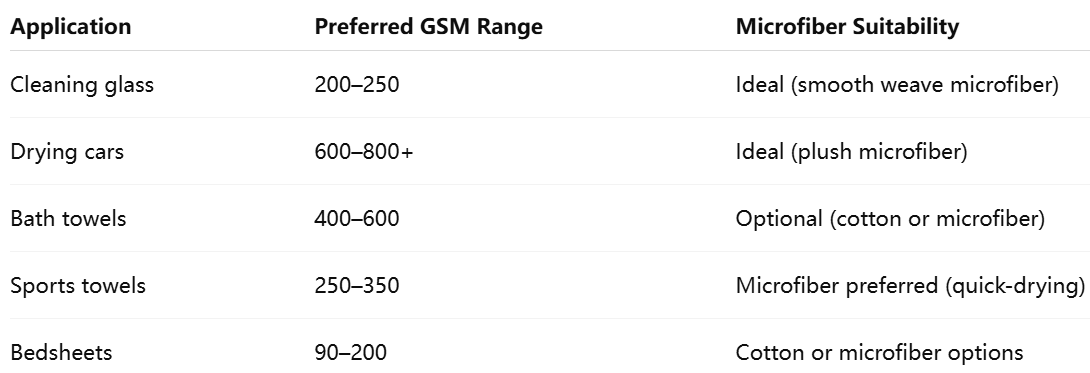When shopping for towels, bed sheets, cleaning cloths, or clothing, you may have encountered the terms GSM and microfiber. Although these terms are often used together or in similar contexts, they refer to very different characteristics of fabrics. This article explores the fundamental differences, their relevance, and how they interact in the world of textiles.
1. Definition and Core Difference
GSM (Grams per Square Meter)
Definition: GSM stands for grams per square meter. It is a unit of measurement that expresses the weight or density of a fabric.
Purpose: GSM quantifies how heavy or thick a fabric is. Higher GSM usually indicates a denser, plusher, or more absorbent fabric, depending on the material used.
Example: A towel with 400 GSM is considered lightweight, while one with 600 GSM is heavier and more luxurious.
Microfiber
Definition: Microfiber refers to a type of synthetic fiber, typically made from polyester, polyamide (nylon), or a blend of both. The defining feature is the fiber diameter, which is less than 1 denier—finer than a strand of silk.
Purpose: Microfiber fabrics are designed to be soft, lightweight, and highly absorbent. Their ultra-fine fibers allow for enhanced cleaning ability, water absorption, and softness.
Example: Microfiber cleaning cloths are commonly used for their ability to trap dust and oils without chemical cleaners.
Key Difference: GSM is a measurement of fabric weight, while microfiber is a material type or fiber structure.
2. What GSM Tells You About Fabric
GSM Range Fabric Type Typical Use Cases
100–200 Light, thin fabrics T-shirts, summer sheets, cleaning cloths
200–400 Medium-weight fabrics Standard towels, activewear, bedsheets
400–600 Heavy-duty fabrics Luxury towels, bathrobes, winter sheets
600+ Extra-thick fabrics Premium hotel towels, absorbent cloths
High GSM: Indicates thicker, denser, and usually more absorbent fabric.
Low GSM: Lightweight, dries faster, more breathable.
Important: Two microfiber towels can have very different GSM ratings, meaning one could be much heavier and more absorbent than the other.
3. Microfiber: Composition and Benefits
Structure
Fineness: Microfibers are typically 1/100th the diameter of human hair.
Split fibers: Many cleaning microfibers are "split" during manufacturing, increasing their surface area and absorbency.
Weave types: Includes waffle weave, terry, suede, or knitted weaves for different uses.
Advantages of Microfiber
Superior cleaning ability (picks up bacteria, dust, and oils effectively)
Highly absorbent (can absorb up to 7x its weight in water)
Quick-drying
Lint-free and non-abrasive
Durable and reusable (can withstand hundreds of washes)
4. Combining GSM and Microfiber
When buying microfiber products, you’ll often see GSM mentioned in the product description. Here’s how they work together:
Low-GSM microfiber (200–300):
Lightweight, less absorbent
Dries quickly
Good for glass cleaning or electronics
Mid-GSM microfiber (300–500):
Balanced absorbency and weight
Ideal for general-purpose cleaning cloths, gym towels
High-GSM microfiber (500–800+):
Ultra-plush, thick, and luxurious
Great for drying cars, body towels, or spa use
Thus, GSM in microfiber products tells you how dense and absorbent the fabric is, but not what it’s made of—that’s where the microfiber label comes in.
5. Practical Use Cases: GSM vs. Microfiber
6. Myths and Misunderstandings
Myth: “Higher GSM always means better quality.”
Reality: A higher GSM means heavier, but not necessarily “better.” Use-case matters. For example, a lightweight microfiber towel may outperform a high-GSM cotton towel in portability and drying time.
Myth: “All microfiber is the same.”
Reality: Microfiber varies widely in quality, weave, fiber length, and split vs. non-split design.
Myth: “Microfiber isn’t absorbent.”
Reality: High-quality split microfiber is more absorbent than most natural fibers, pound for pound.
7. Environmental and Care Considerations
Microfiber is synthetic, so washing releases microplastics. Use laundry filters or bags (e.g., Guppyfriend) to reduce environmental impact.
Care Tips:
Avoid fabric softeners (they clog microfiber pores)
Wash in cool/warm water
Air dry or tumble dry low
Conclusion
GSM and microfiber refer to completely different aspects of fabric:
GSM is a quantitative measurement—useful to compare weight and density.
Microfiber is a type of material—valued for its fine structure, softness, and utility.
When shopping or evaluating fabric, understanding both helps you choose the right material for the task—be it cleaning, drying, or sleeping. Look at both the GSM rating and the fiber type to assess performance, durability, and value.


 English
English CN
CN













